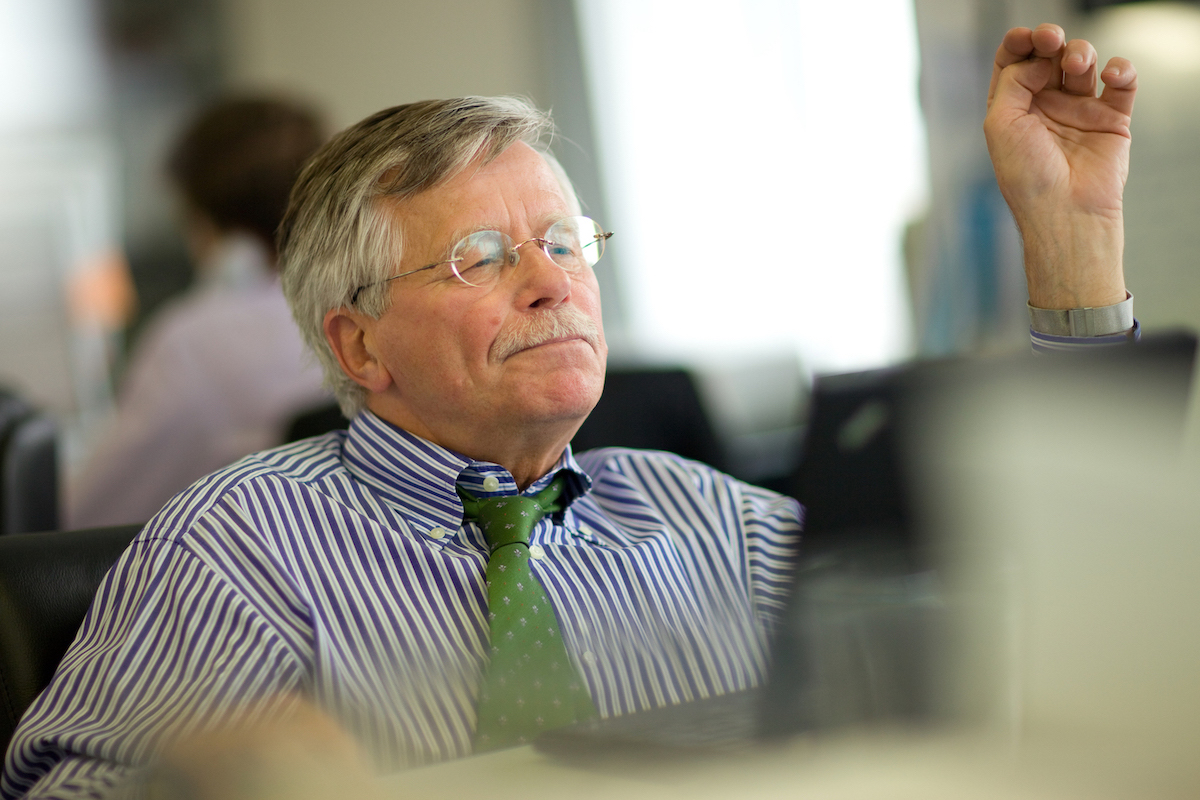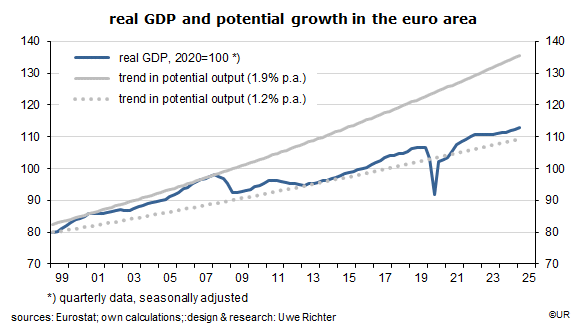
Market Commentary: ECB about to stop cutting rates – for the time being
Since June 2024 the European Central Bank has cut policy rates eight times, from 4% (for the deposit rate) to 2% now, but for the governing council, it is not urgent any longer to proceed on that path. Enough is enough. The neutral rate – which has neither expansionary nor restrictive effects on the economy – is probably in the neighborhood of 3%, the product of the medium-term inflation target of 2% and real GDP trend growth of presently 1.2%. In other words, a policy rate of 2% supports the economy quite significantly, and a pause may be called for, not least because long-term government bond yields have been stable around 2½% for many months; it could be a sign that inflation expectations are no longer declining. For European monetary policy makers, they are where they should be. No need for further actions?
It could be that inflation is near a turning point by now. Consumer price inflation had been plus 1.9% year-on-year in May, but labor costs, the main macro-economic cost component, have increased strongly until most recently: between the third quarter of 2024 and the first quarter 2025 they rose at an annualized rate of 3.5%, while the average rate over the past four years had been even higher: 4.3%.
These are, of course, lagging indicators. More recent labor market data suggest that these numbers cannot be extrapolated: job openings are on the way down since 2022 (if only gradually), employment is either stagnating or rising very slowly (data are released with a very long time lag), and the unemployment rate has fluctuated between 6.2% and 6.4% for more than a year. The seemingly endless near-stagnation of real GDP is leaving its traces.
For me, the main predictor of future inflation is the so-called output gap, the difference between the actual and potential output of the economy. The larger the gap the lower the risks that inflation will accelerate. This is admittedly not a strictly defined and generally accepted concept. Under the assumption that euro area real GDP trend growth since 2008 has been the same as in the previous business cycle (1.9% p.a.) the actual output gap turns out to be a whopping 17% – deflation would almost be certain. If, however, there has been a structural break around the year 2008 (the Great Financial Crisis) which has reduced trend growth to about 1% annually, then there would be no output gap, or a very small one – we should then prepare for rising inflation. This is, by the way, the conclusion of economists at Germany’s research institutes, at the EU Commission or the ECB, more or less. The OECD estimates that the present output gap is 0.8% of potential real gross domestic product, ie, almost non-existent.

On balance, and in spite of fairly strong wage pressures, there is almost no risk that the European inflation rate might rise sustainably beyond the 2% target. It helps that the euro has appreciated from 1.03 to 1.17 dollars since the beginning of the year, that the oil prices have dropped a lot after the truce in the war between Israel, the US and Iran and that the growth rate of the world economy is visibly declining, including such important countries as China and the United States.
The global output gap is clearly widening, price competition is therefore intensifying – which means it is not so easy any longer to raise wages and prices. Moreover, Trump’s new trade barriers force a big player such as China and others to seek alternative outlets for their products. Europe is the most obvious target market – and is thus likely to move toward deflation again. Deflation is the main risk here, not inflation.
Since the ECB continues to insist it has no predetermined idea about future inflation and policy rates, and describes its policies as data-driven, declining inflation rates could well lead to a further reduction of the deposit rate and the two other policy rates, as well as new rounds of quantitative easing. Who can exclude a return to a negative deposit rate? Our neighbor Switzerland is already coming close to such a decision.
About Wermuth Asset Management
Wermuth Asset Management (WAM) is a Family Office which also acts as a BAFIN-regulated investment consultant.
The company specializes in climate impact investments across all asset classes, with a focus on EU “exponential organizations” as defined by Singularity University, i.e., companies which solve a major problem of humanity profitably and can grow exponentially. Through private equity, listed assets, infrastructure and real assets, the company invests through its own funds and third-party funds. WAM adheres to the UN Principles of Responsible Investing (UNPRI) and UN Compact and is a member of the Institutional Investor Group on Climate Change (IIGCC), the Global Impact Investing Network (GIIN) and the Divest-Invest Movement.
Jochen Wermuth founded WAM in 1999. He is a German climate impact investor who served on the steering committee of “Europeans for Divest Invest”. Jochen was on the founding investment committee of Germany’s SWF KENFO from June 2017 until February 2024.
Legal Disclaimer
The information contained in this document is for informational purposes only and does not constitute investment advice. The opinions and valuations contained in this document are subject to change and reflect the viewpoint of Wermuth Asset Management in the current economic environment. No liability is assumed for the accuracy and completeness of the information. Past performance is not a reliable indication of current or future developments. The financial instruments mentioned are for illustrative purposes only and should not be construed as a direct offer or investment recommendation or advice. The securities listed have been selected from the universe of securities covered by the portfolio managers to assist the reader in better understanding the issues presented and do not necessarily form part of any portfolio or constitute recommendations by the portfolio managers. There is no guarantee that forecasts will occur.
Read the full article in PDF format here: English.